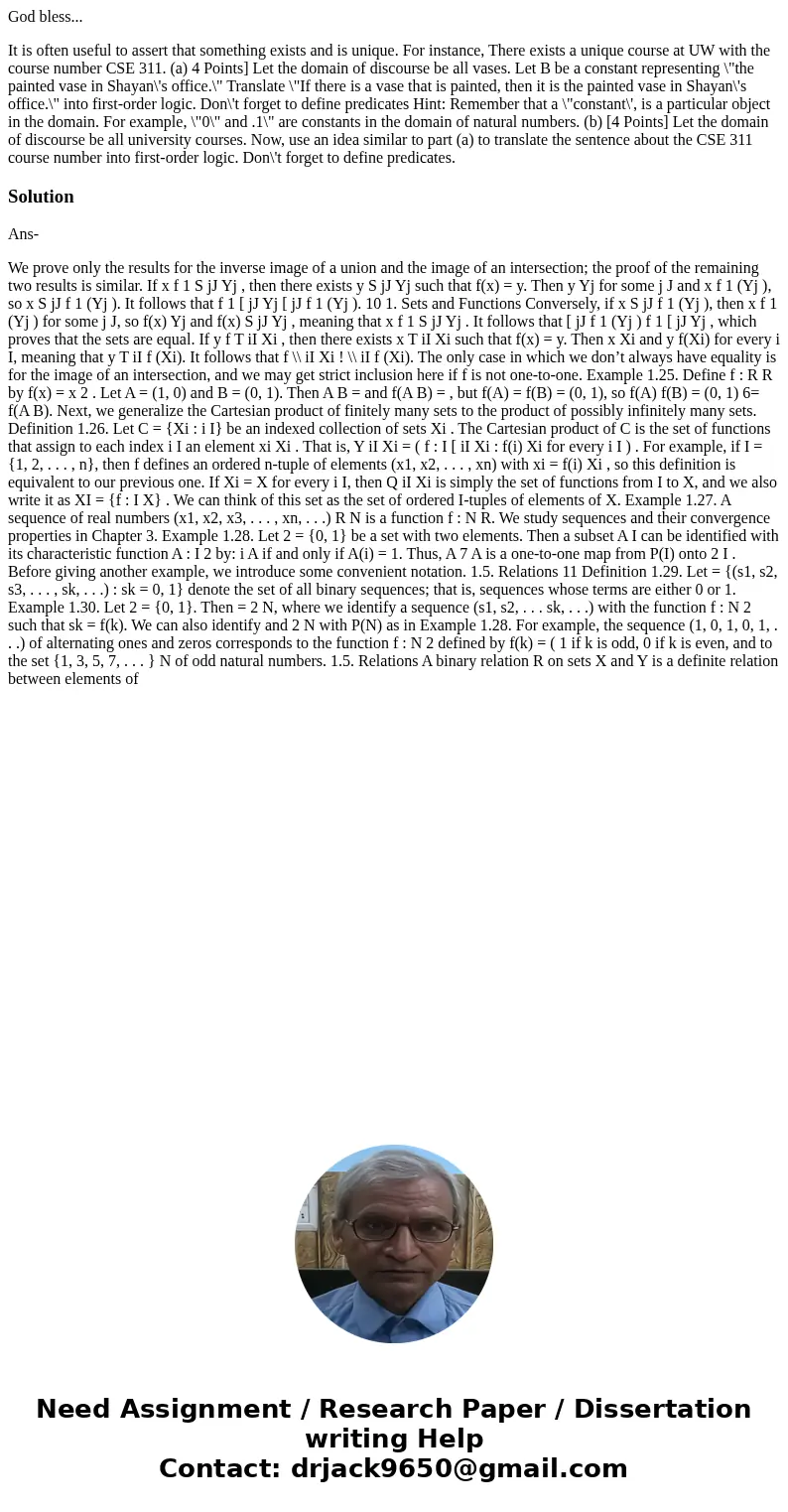God bless It is often useful to assert that something exists
God bless...
It is often useful to assert that something exists and is unique. For instance, There exists a unique course at UW with the course number CSE 311. (a) 4 Points] Let the domain of discourse be all vases. Let B be a constant representing \"the painted vase in Shayan\'s office.\" Translate \"If there is a vase that is painted, then it is the painted vase in Shayan\'s office.\" into first-order logic. Don\'t forget to define predicates Hint: Remember that a \"constant\', is a particular object in the domain. For example, \"0\" and .1\" are constants in the domain of natural numbers. (b) [4 Points] Let the domain of discourse be all university courses. Now, use an idea similar to part (a) to translate the sentence about the CSE 311 course number into first-order logic. Don\'t forget to define predicates.Solution
Ans-
We prove only the results for the inverse image of a union and the image of an intersection; the proof of the remaining two results is similar. If x f 1 S jJ Yj , then there exists y S jJ Yj such that f(x) = y. Then y Yj for some j J and x f 1 (Yj ), so x S jJ f 1 (Yj ). It follows that f 1 [ jJ Yj [ jJ f 1 (Yj ). 10 1. Sets and Functions Conversely, if x S jJ f 1 (Yj ), then x f 1 (Yj ) for some j J, so f(x) Yj and f(x) S jJ Yj , meaning that x f 1 S jJ Yj . It follows that [ jJ f 1 (Yj ) f 1 [ jJ Yj , which proves that the sets are equal. If y f T iI Xi , then there exists x T iI Xi such that f(x) = y. Then x Xi and y f(Xi) for every i I, meaning that y T iI f (Xi). It follows that f \\ iI Xi ! \\ iI f (Xi). The only case in which we don’t always have equality is for the image of an intersection, and we may get strict inclusion here if f is not one-to-one. Example 1.25. Define f : R R by f(x) = x 2 . Let A = (1, 0) and B = (0, 1). Then A B = and f(A B) = , but f(A) = f(B) = (0, 1), so f(A) f(B) = (0, 1) 6= f(A B). Next, we generalize the Cartesian product of finitely many sets to the product of possibly infinitely many sets. Definition 1.26. Let C = {Xi : i I} be an indexed collection of sets Xi . The Cartesian product of C is the set of functions that assign to each index i I an element xi Xi . That is, Y iI Xi = ( f : I [ iI Xi : f(i) Xi for every i I ) . For example, if I = {1, 2, . . . , n}, then f defines an ordered n-tuple of elements (x1, x2, . . . , xn) with xi = f(i) Xi , so this definition is equivalent to our previous one. If Xi = X for every i I, then Q iI Xi is simply the set of functions from I to X, and we also write it as XI = {f : I X} . We can think of this set as the set of ordered I-tuples of elements of X. Example 1.27. A sequence of real numbers (x1, x2, x3, . . . , xn, . . .) R N is a function f : N R. We study sequences and their convergence properties in Chapter 3. Example 1.28. Let 2 = {0, 1} be a set with two elements. Then a subset A I can be identified with its characteristic function A : I 2 by: i A if and only if A(i) = 1. Thus, A 7 A is a one-to-one map from P(I) onto 2 I . Before giving another example, we introduce some convenient notation. 1.5. Relations 11 Definition 1.29. Let = {(s1, s2, s3, . . . , sk, . . .) : sk = 0, 1} denote the set of all binary sequences; that is, sequences whose terms are either 0 or 1. Example 1.30. Let 2 = {0, 1}. Then = 2 N, where we identify a sequence (s1, s2, . . . sk, . . .) with the function f : N 2 such that sk = f(k). We can also identify and 2 N with P(N) as in Example 1.28. For example, the sequence (1, 0, 1, 0, 1, . . .) of alternating ones and zeros corresponds to the function f : N 2 defined by f(k) = ( 1 if k is odd, 0 if k is even, and to the set {1, 3, 5, 7, . . . } N of odd natural numbers. 1.5. Relations A binary relation R on sets X and Y is a definite relation between elements of

 Homework Sourse
Homework Sourse